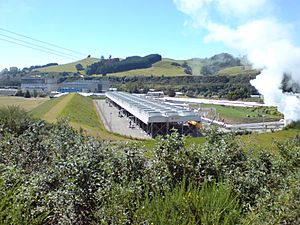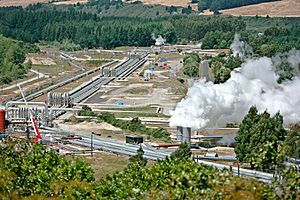Wairakei Power Station facts for kids
Quick facts for kids Wairakei Power Station |
|
|---|---|

The Wairakei Power Station, with the main two blocks at the left rear. The binary plant is in front.
|
|
| Country | New Zealand |
| Location | Wairakei, north of Taupo |
| Coordinates | 38°37′37″S 176°06′19″E / 38.62694°S 176.10528°E |
| Status | Operational |
| Commission date | November 1958 |
| Owner(s) | Contact Energy |
The Wairakei Power Station is a special kind of power plant in New Zealand. It uses heat from deep inside the Earth to make electricity. This heat comes from the Wairakei Geothermal Field, which is part of the Taupo Volcanic Zone.
Contents
How Wairakei Power Station Began
The Wairakei Power Station was built in 1958. It was the very first power plant in the world to use "wet steam" to create electricity. This means it used steam directly from underground.
Today, the company Contact Energy owns and runs the power station. In 2005, a new part was added called a "binary cycle power plant." This new part uses steam that is not as hot, after it has already gone through the main plant. This helped the station make even more electricity, reaching a total of 181 megawatts (MW).
The Wairakei power station is slowly being replaced. From 2013, a newer plant called the Te Mihi geothermal power station started taking over. Another power station, the Poihipi Power Station, was built nearby in 1996.
Power Generating Units
The Wairakei Power Station has different parts, or "units," that work together to make electricity.
Wairakei A Station
This part of the station has several units that use steam at different pressures to generate power.
- Unit 1 – 11.2 MW (intermediate pressure)
- Unit 4 – 11.2 MW (intermediate pressure)
- Unit 7 – 11.2 MW (low pressure)
- Unit 8 – 11.2 MW (low pressure)
- Unit 9 – 11.2 MW (low pressure)
- Unit 10 – 11.2 MW (low pressure)
Some older units (Units 2, 3, 5, and 6) were stopped in 1984.
Wairakei B Station
This section has three larger units.
- Unit 11 – 30 MW (intermediate/low pressure)
- Unit 12 – 30 MW (intermediate/low pressure)
- Unit 13 – 30 MW (intermediate/low pressure)
Other Power Units
There is also a smaller unit:
- Wairakei Unit 14 – 4 MW (intermediate/low pressure)
And the newer part:
- Wairakei Binary Plant – 14 MW (binary cycle)
Impact on the Environment
Using steam from deep underground has changed the area around the power station.
You might see more natural steam and hot water activity in places like Craters of the Moon. This happens because the water levels underground change. Also, the ground has sunk a little in some places over the years. The amount of steam coming from the ground has also gone down.
Even with these changes, the power station still makes a lot of electricity. New parts, like the binary plant built in 2005, help use the heat more efficiently. This helps keep the electricity production high.
Managing Water and Heat
The hot water used by the power station is actually rainwater that has soaked into the ground and been heated by hot rocks. After the power station uses this hot water, much of it is pumped back underground. This helps to keep the ground warm and reduces how much heat is taken from the Earth.
The power station also releases a very small amount of a natural substance called arsenic into the Waikato River. The amount is very tiny, about 0.035 grams in a cubic meter of water in some spots. As the river flows further away, the amount of arsenic becomes even lower.
How Electricity is Sent Out
At Wairakei, there is a very important electrical substation. This substation is like a big hub for electricity in the middle of the North Island. It is owned by Transpower, which manages the national electricity grid.
This substation connects more than half of New Zealand's geothermal power stations. It also connects several hydroelectric power stations (which use water to make power). From here, electricity is sent to places like the entire Hawke's Bay and Gisborne regions, and half of the Bay of Plenty region. A smaller connection from the substation also supplies electricity to the local Taupo area.




